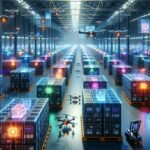Artificial Intelligence (AI) in precision agriculture is reshaping the landscape of farming, offering innovative solutions to age-old challenges. This transition towards more scientific and data-driven approaches promises to enhance productivity and sustainability in agriculture. By integrating AI technologies, farmers gain access to invaluable insights and predictive analytics, enabling them to make informed decisions that benefit both their yields and the environment.
Understanding AI in Precision Agriculture
AI in precision agriculture uses cutting-edge technology to transform the way farmers understand and interact with their land. By employing sophisticated algorithms and machine learning, the system can analyze data from various sources like satellites, drones, and sensors deployed in the field. These technologies collect extensive information on soil health, moisture levels, temperature, and crop health, empowering farmers with real-time insights.
The heart of AI’s application in farming lies in its predictive capabilities. Machine learning models train on historical agricultural data, enabling them to predict future outcomes based on current conditions. This could range from anticipating the optimal planting season for a crop, determining the exact amount of water needed for irrigation, or predicting potential pest outbreaks before they become a significant threat.
One practical application is precision soil sampling. Traditional methods involved sending soil samples to a lab for analysis, which was time-consuming and often not representative of the entire field. AI-driven methods, in contrast, provide a more detailed and quicker analysis, helping in making immediate decisions on fertilization and crop rotation plans.
Crop monitoring takes a leap forward with AI by using aerial images from drones or satellites. Advanced image processing technologies identify areas of stress in plants, nutrition deficiencies, or disease symptoms not visible to the naked eye. This level of monitoring assists in applying corrective measures promptly and accurately, minimizing wastage of resources.
AI also enhances efficiency through agriculture robotics. Robots equipped with AI can perform tasks such as weeding, spraying pesticides, and harvesting. These robots are designed to recognize the difference between crops and weeds or ripe and unripe fruits, ensuring that actions are precisely targeted, thereby reducing manual labor costs and increasing the efficacy of these operations.
Customized recommendations for crop management represent another crucial aspect of AI in precision agriculture. By integrating data from various sources, AI systems offer personalized advice on the best crop varieties for a particular field, anticipating market demands, thus helping farmers in planning more rewarding cropping strategies.
With the adoption of AI technologies, farmers are set on a path toward sustainability. Practices such as precise irrigation and fertilizer application reduce water usage and chemical runoff, contributing positively to environmental conservation efforts.
In essence, AI is remodeling the agriculture landscape, making it more scientific, efficient, and sustainable. By leveraging vast datasets for insights and predictions, it stands as a cornerstone technology that promises to elevate the global agriculture industry to new heights of productivity and environmental responsibility.

The Impact of AI on Crop Management
AI not only revamps the way we approach farming but also redraws the boundaries of what’s achievable in crop management. With predictive analytics at its core, AI empowers farmers to foresee crop yields with astonishing accuracy, ensuring that they can plan for the future with more confidence. This crystal ball into the cyclical nature of farming is not just about quantity but also about quality, allowing for adjustments in farming practices that align with anticipated outcomes.
The battle against crop diseases receives a significant boost from AI. Through advanced detection systems, AI identifies potential outbreaks before they become problematic. This proactive approach to plant health is akin to having a doctor on call 24/7, exclusively for crops. The magic lies in the combination of visual data from drones above with insights from sensors in the soil, creating a comprehensive picture of a crop’s health deep below the surface and far above it.
Precision spraying technology steered by AI marks the dawn of a new era in resource utilization. Traditionally, blanket approaches to pesticide and nutrient application not only wasted resources but also heightened environmental concerns. Enter AI, and now we have systems smart enough to pinpoint exactly where and how much of a substance a particular crop section requires. This precision ensures that every drop of pesticide and every granule of fertilizer is used optimally, reducing waste and safeguarding surrounding ecosystems.
AI’s transformative role extends to optimizing water use, perhaps the most critical resource in agriculture. By analyzing weather forecasts, soil moisture levels, and plant health data, AI systems can determine the optimal irrigation schedule for each crop field. This results to a remarkable reduction in water wastage, contributing significantly to conservation efforts while ensuring crops receive the right amount of water at the right time.
The gift of foresight provided by AI’s predictive analytics offers a greener path to farming. By forecasting the precise amounts of inputs needed for crop cultivation, farmers can minimize excess use of fertilizers, pesticides, and water, leading to a form of farming that respects and protects our environment. This alignment with sustainability goals portrays AI not merely as a tool for enhancing efficiency but as a partner in the mission to cultivate responsibly for future generations.
Robotics, empowered by AI, transcend everyday tasks, venturing into the realm of advanced crop management. These intelligent machines handle everything from planting seeds tailored to the soil’s needs to harvesting crops at their peak ripeness. The mundane and strenuous tasks that once defined farming now fall within the domain of these tireless mechanical helpers, allowing farmers to focus on strategic decisions and broader farm management issues.
AI platforms provide personalized recommendations tailored to the unique needs of each farm, thereby revolutionizing the crop management process. By analyzing vast amounts of data from various sources, these systems suggest specific actions that farmers can take to improve crop health, yield, and overall farm efficiency. This bespoke advice covers everything from optimal planting schedules to pest management strategies, delivering a level of guidance that was previously unimaginable.
In considering the future of farming, AI stands as a cornerstone technology driving advancements. Through its predictive powers and precision capabilities, AI transforms crop management into an endeavor marked by increased predictability and productivity. The potential benefits of AI in agriculture extend far beyond individual farms, hinting at a future where farming practices worldwide are more efficient, sustainable, and in harmony with the global ecosystem. As we continue to unlock AI’s full potential, its contributions to agriculture promise not only more bountiful harvests but also a brighter future for our planet.
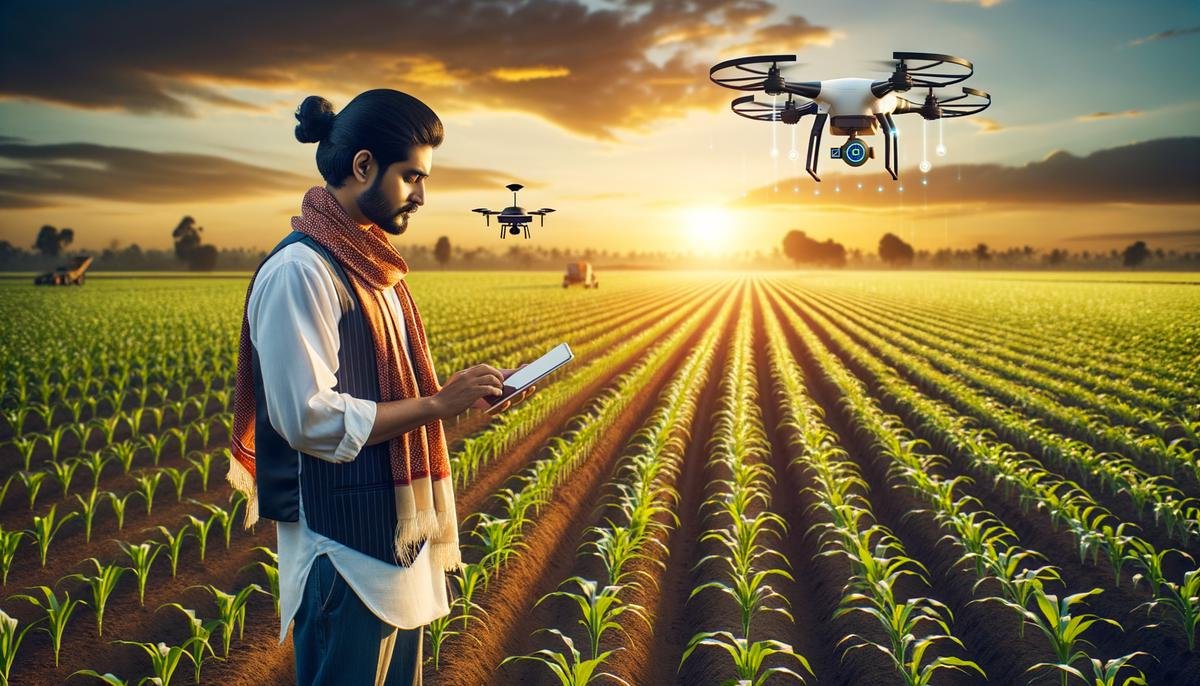
AI-Driven Soil and Water Management
Moisture sensors nestled in the depths of soil are quietly revolutionizing the way farmers understand their fields. They work day and day out, measuring the levels of moisture present and relaying this data back to AI systems poised to make real-time decisions.
This conversation between below-ground sensors and AI doesn’t stop at moisture levels. It extends to evaluating soil conditions, including determining when the land is too dry or sufficiently moist, thereby advising on the precise moment for irrigation. This level of precision ensures water is employed wisely, directing it towards crops that thirst and holding back when nature promises rain.
Furthermore, employing AI to analyze soil health extends beyond moisture. It involves decoding the myriad of secrets soil holds about nutrients and pH levels. AI algorithms compare this data against vast libraries of crop requirements, thus guiding farmers on what, where, and when to plant for optimum growth without overtaxing water resources.
Water management benefits enormously from AI’s forecasting abilities. Predicting weather patterns, calculating evaporation rates, and understanding crop water needs allow for a dynamic irrigation strategy. This results in a water-saving technique that not only conserves precious H2O but ensures it’s used efficiently for crops genuinely in need.
AI’s role in soil and water management crosses into drought management as well. Algorithms can designate the risk of droughts well in advance, initiating conservation practices early to buffer the impact on crops and soil. These preemptive strikes against drought are invaluable in preserving both the health of the soil and the livelihoods of those that till it.
In a world where water scarcity is an ever-increasing concern, these AI-driven tools offer a beacon of hope. For farmers, this means harnessing technology to not only maintain but improve crop yields with minimal water use. For the environment, it signals a move towards practices that respect finite resources while feeding an ever-growing population.
Soil erosion detection powered by AI takes sustainability a step further. By recognizing patterns that indicate erosion risk, such as heavy rainfall events or incorrect plowing techniques, farmers can adapt practices to protect their soil. Protecting soil ensures it remains fertile and capable of retaining water, a critical element in combating both water waste and scarcity.
Lastly, integrating AI into soil and water management solidifies a future wherein decisions are not just educated but insightful. It’s a future where every drop of water counts, where soil health forms the basis of agricultural strategies, and where sustainability isn’t just a goal but a practical achievement.
This movement towards AI in managing these natural resources marks a shift in not only agriculture practices but in acknowledging the interdependence between technology, the earth, and its burgeoning populations. An interdependence that, if nurtured, promises a thriving planet for generations to come.
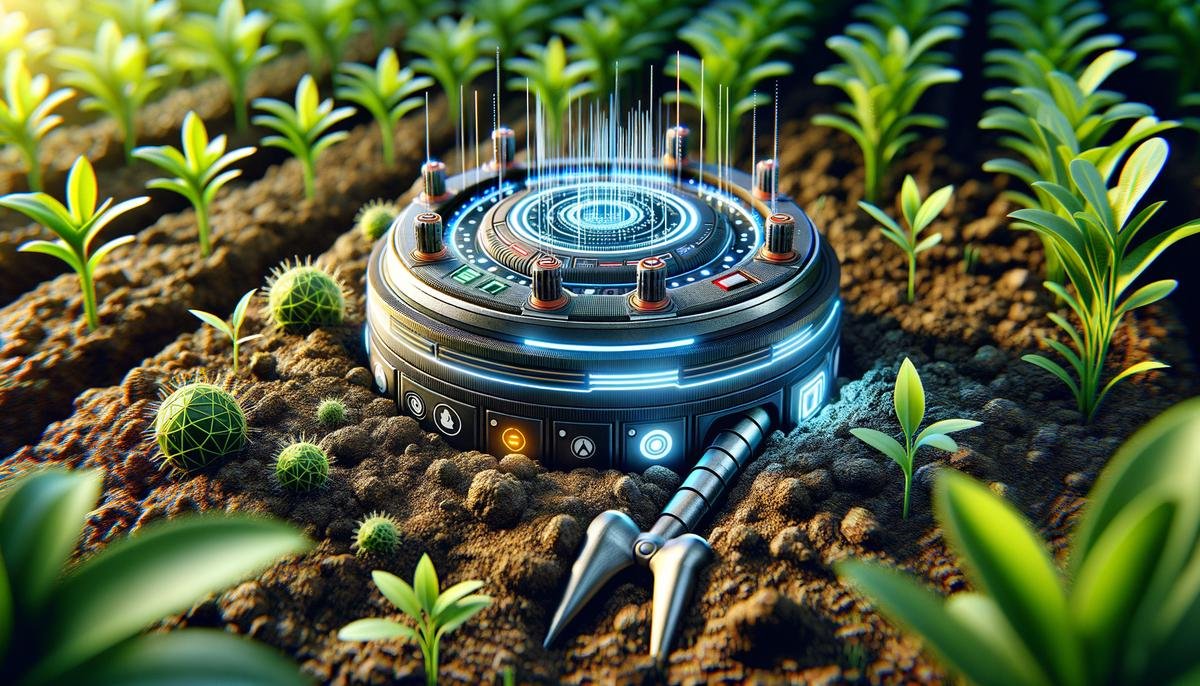
The Role of Drones and Robotics in Precision Agriculture
Drones and Robotics Revolutionizing AI-Driven Farming
Drones and robotics play an increasingly crucial role in the implementation of AI-driven farming, streamlining operations where precision and efficiency are paramount. These technologies, equipped with advanced AI, revolutionize traditional farming methods by providing aerial imaging, automated planting, and harvesting solutions.
Aerial imaging via drones offers a birds-eye view of farmlands, enabling farmers to assess crop health, monitor growth rates, and even detect pest infestations from above. This vantage point is invaluable, as it gives a comprehensive picture of the field that can’t be achieved from the ground. Drones are equipped with sophisticated sensors and imaging technologies that capture detailed photographs and thermal imagery, pinpointing variations in the field that might indicate issues like irrigation problems or soil health concerns.
On the ground, robotics are transforming the way crops are planted, tended, and harvested. Autonomous tractors and planters can navigate fields with precision accuracy, sowing seeds at optimal depths and spacings without human intervention. These machines can operate around the clock, vastly increasing productivity while reducing the labor costs associated with traditional farming methods.
When it comes to crop care, robotic systems are equally transformative. Equipped with advanced sensors, these robots can identify weeds among crops and selectively spray herbicides to eliminate them, significantly reducing the amount of chemicals used on the farm. This targeted approach not only saves on costs but also minimizes environmental impact, aligning with sustainable farming objectives.
Harvesting sees the introduction of robotic pickers that gently and efficiently collect ripe produce. These systems can be programmed to recognize when fruit is at its peak ripeness, ensuring that produce is harvested at the exact right moment for optimal quality. This level of precision reduces waste and maximizes yield, as each plant is given the attention it needs to thrive.
Beyond fieldwork, drones and robotics are integral to data collection and analysis, feeding information into AI systems that process and generate actionable insights. For instance, data from drone imagery can be analyzed to forecast yields, allowing farmers to make informed decisions on crop management and sales.
In pest management, drones can deploy biological control agents directly to affected areas. This method, known as precision biocontrol, minimizes the use of pesticides while effectively managing pest populations. Robotics equipped with UV lights roam fields at night, targeting harmful insects without disturbing the crops.
As collaborative technologies, drones and robotics also contribute to soil conservation efforts. By optimizing planting patterns and routes for machinery, they help reduce soil compaction and erosion, preserving the land’s integrity for future cultivation.
By integrating drones and robotics into AI-driven farming systems, farmers achieve levels of efficiency and precision once thought impossible. These innovations promise not just to enhance agricultural productivity but also to foster environmental stewardship, making modern farming a key player in the quest for sustainability in an ever-growing world.
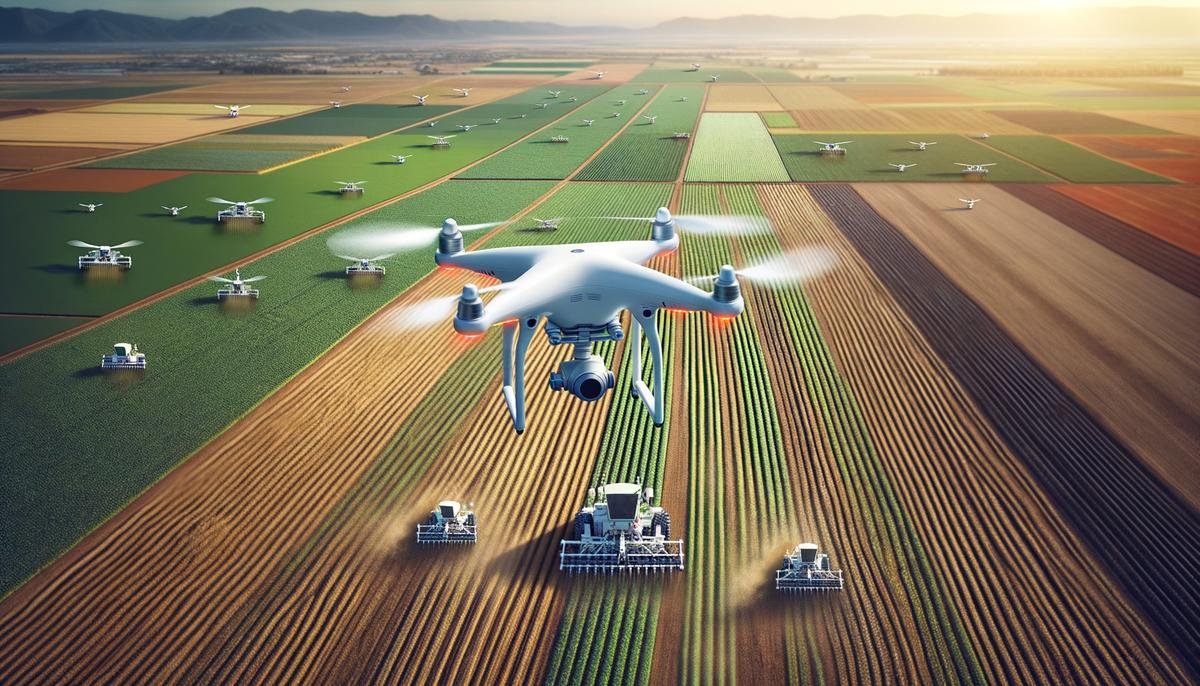
Challenges and Solutions in Implementing AI in Farming
Understanding and troubleshooting AI systems require both technical knowledge and a comfort level with data interpretation. Farmers traditionally rely on experience and instinct, making the transition to data-driven practices daunting due to its complexity. To bridge this gap, offering hands-on training sessions and easy-to-understand manuals could enhance digital literacy, enabling a smoother transition to AI technologies.
Financial barriers pose a significant challenge as well. The initial investment in AI technology and the infrastructure to support it can be prohibitive for small to medium-sized farms. Subsidies and financial assistance programs from governments or private entities can play a crucial role in overcoming these economic hurdles. These aids could reduce the upfront costs of AI adoption, making advanced agricultural technologies accessible to a broader range of farmers.
Moreover, the infrastructure necessary to support AI, including reliable internet connections and technology maintenance, is not always available in rural areas. Developing robust rural technological infrastructure, possibly through public-private partnerships, is essential for the wide-scale adoption of AI in agriculture.
Another challenge lies in the integration of AI systems with existing agricultural practices. The compatibility of new technologies with current farming systems often requires customization, which can further escalate costs and technical complications. To address this, AI solutions designed with scalability and adaptability in mind are crucial. These solutions should be able to integrate seamlessly with various types of agricultural operations, reducing the need for expensive custom modifications.
Furthermore, concerns about data privacy and ownership also inhibit AI adoption in agriculture. Farmers may hesitate to adopt AI solutions due to fears that their farm data could be misused or stolen. Establishing clear regulations that protect farmers’ rights regarding their data is critical to building trust. Organizations developing AI tools must prioritize data security and transparency about how they use and share agricultural data.
To capitalize fully on the potential of AI in agriculture, ongoing support and education are necessary. This could take the form of technical support teams or advisory services that assist with troubleshooting and optimizing AI technologies. Creating peer networks or forums for farmers to share their experiences and solutions related to AI can also foster a supportive community around these new technologies.
In summary, tackling the hurdles of AI adoption in agriculture requires a comprehensive approach addressing technical, financial, infrastructural, and legal challenges. Through education, government incentives, scalable technology solutions, and a particular focus on building a supportive community among farmers, these challenges can be met head-on. This way, the agricultural sector can move toward a more innovative and sustainable future with AI at its core.

Future Trends in AI and Precision Agriculture
As we gaze into the crystal ball of AI-driven precision agriculture’s future, the next leaps seem nothing short of revolutionary. Given the strides we’ve already observed, the horizon promises a fusion of technology and farming practices that were once considered the stuff of science fiction.
Imagine smart drones that don’t just monitor crops but also have the capability to make real-time interventions. These aerial marvels might detect a section of crops showing early signs of distress and instantly deploy targeted nutrients or hydration to those specific areas, essentially conducting micro-interventions that preserve resources while boosting crop health.
In the vein of sustainability, bioengineered sensors could become the norm, blending seamlessly with plants to monitor their health and needs directly. These living sensors would communicate with AI systems to provide unparalleled insights into plant biology, further optimizing water usage and nutrient distribution with a finesse that manual methods could never achieve.
The blending of AI with gene editing technologies like CRISPR could open up new avenues for creating crops that are not only more resistant to pests and diseases but can also provide real-time feedback on their health status through embedded biological sensors. This could drastically reduce the need for chemical inputs like pesticides and herbicides, making agriculture cleaner and more sustainable.
Beyond the farm, AI is set to revolutionize supply chains. Predictive logistics powered by AI could vastly improve the efficiency of how produce is transported from farm to table, reducing waste and ensuring fresher goods. This system would analyze data from myriad sources to predict and mitigate potential disruptions in the supply chain, ensuring a smooth flow of goods even amidst unforeseen challenges.
In an effort to close the loop of farm sustainability, AI may helm the development of carbon capture techniques within agriculture. By analyzing vast datasets, AI systems could identify the most effective methods and locations for sequestration endeavors on farms, turning agriculture into a key player in global efforts to combat climate change.
The aforementioned points only scratch the surface. Farmers themselves might see a transformation into “agri-technicians,” equipped with wearable AI devices that offer real-time insights and decision-making support directly in the field. This blend of human intuition with machine precision could elevate farming efficiency to unprecedented levels.
Moreover, AI-facilitated direct consumer-farmer connections could guide the production process, tailoring it to meet current demands precisely. Imagine a system where consumer preferences and consumption patterns drive the cultivation of crops, facilitated through an intricate AI-powered platform. This direct line not only ensures market relevance but also fosters a closer relationship between consumers and those who grow their food, adding depth to the farm-to-fork narrative.
Ultimately, the journey towards these horizons depends on bridging current gaps in technology adoption, infrastructure, and educational efforts among farming communities. The integration of AI in farming is as much about fostering human-machine collaboration as it is about the technology itself. The cultivation of this synergy promises a future where precision agriculture not only meets the demands of a growing population but does so in a manner that enriches both the earth it draws from and those it nourishes.
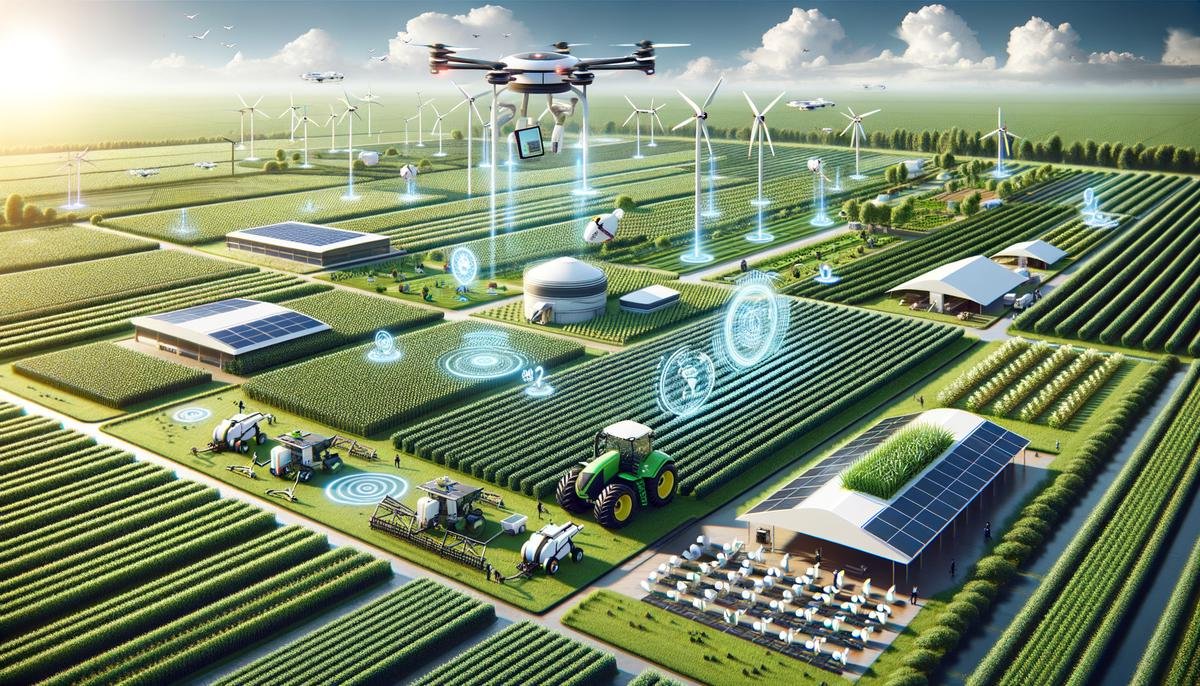
In conclusion, the integration of AI into precision agriculture stands as a transformative force, poised to redefine the future of farming. By harnessing the power of data and predictive analytics, it offers a pathway to increased efficiency and sustainability. This pivotal technology not only elevates agricultural practices but also aligns them with environmental conservation efforts, ensuring a prosperous future for both our global food systems and the planet.




